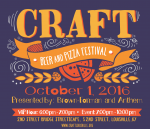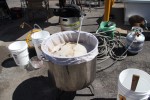Near the beginning of this year’s LCBW, the esteemed Jerry Gnagy and I had the opportunity to attend a District Philadelphia Technical Meeting of the Master Brewers Association of the Americas (MBAA). There are nearer districts, but this topic looked crazy fun, so we made the voyage anyway. “What could drag you away from a day or two of LCBW?” you may or may not ask. I will tell you, faithful readers: barrel aging! While it is certainly true that we have a great deal of experience barrel aging already, it is even more true that there is always someone out there who knows more than you do, and in a world as complex and storied as barrel aging, there are usually lots of people out there with lots more knowledge about at least some facet of the Art. And boy did we learn.
Since I promised to try for something a little more science-y this week, I think it might be a good idea for me to sum up a few of the things I learned from the four talks that comprised the meeting. All were fascinating and at least partially science-y. To the extent that the information is useful, it very likely came from the individuals giving the talks, and I cannot take any credit for its value. To the extent that the information is fractured, stupid, or blatantly incorrect, it’s likely to be blamed on my poor note taking or beer-addled brain. In either case, I hope you enjoy.
The first talk was by John Haggerty, who is currently Brewmaster at Warped Wing Brewing Company and also spent 10 years as Brewmaster for New Holland Brewing Company where he oversaw their very substantial bourbon barrel program as well as a number of sours and other wood aged products. Whether due to informational density or lack of tiredness, I seem to have more notes on his talk than any of the others. The general crux of the talk was that barrel aged products destined for packaging and distribution require a heightened level of care. The reason for this is that beer that goes straight from the wood to a chilled serving tank remains fairly controlled. As long as the serving tank remains cold, there is very little chance that any organisms picked up from the wood will have any opportunity to flourish and create off-flavors. If the beer tastes good coming out of the barrels, it will probably taste good in the glass.
Beer moved to bottles or cans, however, can sit at a variety of temperatures and conditions for unknown amounts of time before someone finally drinks it. It is one of a packaged brewer’s jobs to make sure the product tastes as close as it possibly can to the original product even after that potential mishandling. Amongst a variety of other interesting points and suggestions, he gave three great suggestions for achieving this goal. All are dependent on some level of (potentially expensive) specialized equipment, so they aren’t possible for everyone but are all still good ideas none-the-less. The first was to QC test each barrel for microbes before extraction. If there isn’t microbial life in the product when it gets sealed in a package, there won’t be later. To that end, you can help control microbial growth in the aging stage with the second suggestion: cold barrel aging. If you have the ability to age below 50 degrees, you might get slower flavor extraction but will also reduce the possibilities of microbial growth. The last suggestion was to sterile filter, pasteurize, and/or chemically stabilize the beer before packaging. All have the potential to impact the flavor of the beer, but a brewer has to weigh that against the possibility of turning packaged beer into poison.
The second talk was by Joe Mohrfeld of Pinthouse Pizza Craft Brewpub in Austin, Texas. The topic was “Wood and Barrels in Small Scale Brewing Operations”. While there was certainly still a lot of interesting information, it was largely stuff that we already knew because we have been barrel aging in small scale operations for years and have already tackled most of the issues he brought up. Spatial challenges were a big portion of his presentation and largely boil down to “be creative and figure it out.” Very true. One point he did bring up that I mostly already knew but hadn’t really given much thought to was that creative blending can make a large array of flavors out of a relatively limited number of aging vessels. Sometimes a little dash of this and a generous pour of that can blend into a rather interesting limited edition flavor. Fascinating. Look for the impact of this little point at AtG in the future.
The third talk was by Eric Salazar of New Belgium Brewing Company. He functions as their Wood Aged Beer Specialist, and his presentation focused on the maintenance and revitalization of wood vessels. Since he works mostly with very, very large foeders, that’s what most of his talk was about, but many of the points could also apply to barrels and other smaller vessels. This material is a little hard to translate because his Powerpoint had a lot of pictures and he said things like, “If it looks like this you can fix it, but if it looks like this, throw it away.” He also discussed the revitalization of barrels using potassium metabisulfite, which is an antimicrobial chemical sterilant. Useful for cleaning out wood when you first get it to make sure that the only weird growth is the weird growth you put in, or when shit has already hit the fan and you want to save the barrel. He also talked at length about some of the tools used for repairing and sealing wood vessels. Again, not much fun unless you see them. He did reiterate the “garlic + chalk = barrel sealing concrete” point that we first heard from Vinnie Ciluruliscurusco (sp?) from Russian River. We tried it once to no effect but it might be worth trying again next time we have a bad leak.
The last presentation at the meeting was nice and science-y but largely based on a number of charts I don’t yet have access to, so you’ll have to just believe me on this. Steve Gonzalez of Stone Brewing Company talked about the particular chemicals in oak and wood vessels that contribute to the flavors we associate with those vessels. There were some really fascinating graphs showing the extractions of various oak-flavor compounds like cis-lactone and vanillin in beer from first use, second use, and beyond. One point I got from him that doesn’t rely on visuals is that some form of agitation can vastly improve the extraction rates from suspended wood such as chips or spirals. Like more than 6 times the extraction. Pretty cool stuff.
Anywho, that’s all I have this time. Unless I attend another technical meeting sometime in the next two weeks, I’ll have to come up with something of my own to talk about next time. We’ll see. Until then, faithful readers, thanks for reading, and happy drinks!
P.S. Remember to let me know if you have some specific topic you would like me to babble about next time. You can tell me in person, by e-mail, or in the comments right down below.





